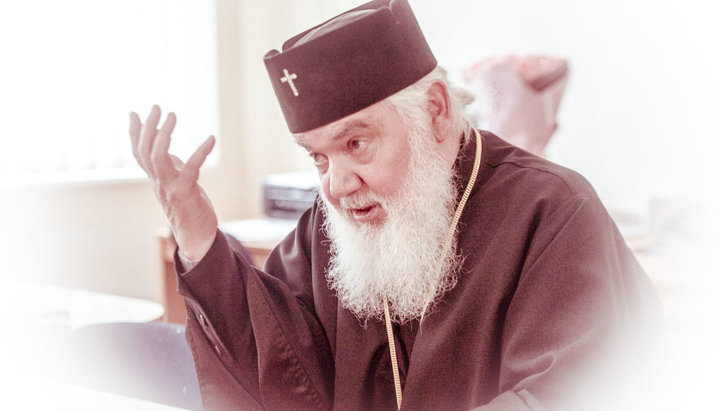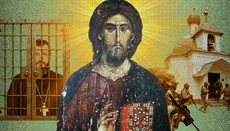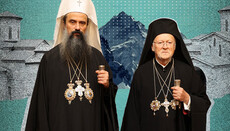On the “canonicity” of UAOC ordinations: from Maximus the Cynic to Chekalin

The article analyses recent publications on the alleged canonicity of the episcopal ordinations of the UAOC, which the Phanar accepted into communion.
Earlier, the “Фως Фanapioy” site has published a story that allegedly Metropolitan Anthony of Hierapolis (Shcherba) secretly “re-ordinated” the entire non-canonical hierarchy of the UAOC, “ordained” by the scandalous and excommunicated deacon from the Russian Church Vikenty Chekalin. However, this version was unconvincing to readers as no evidence was provided. Now the same site is trying to prove that the “Chekalin’s ordinations” of the UAOC were canonical. However, the article by the Ukrainian journalist D. Gorevoy republished by “Фως Фanapioy”, as in previous publications on this topic, has a number of contradictions.
Having examined and analyzed the subject matter, I would like to draw the attention of readers to the next few points from the article by D. Gorevoy.
On Vikenty Chekalin
In the mentioned article, citing an unauthorized Internet resource, it is alleged that Vikenty Chekalin received canonical ordination in 1986 from Metropolitan Alexei (Konoplev) of Kalinin and Kashin, Bishop John (Bodnarchuk) and allegedly “Bishop of the Catacomb Church” Vladimir.
However, it is known that in 1983 Vikenty Chekalin was already defrocked by the Russian Orthodox Church (grounds: theft, sacrilege, marriage) and worked as a school teacher. In 1987, he was sentenced to 3.5 years in prison for “committing sexual assault of minors” (Article 120 of the Criminal Code of the Russian Federation). It is impossible to imagine that, in the interval between these two events, one of the most authoritative and revered metropolitans of the Russian Orthodox Church secretly ordained as bishop the defrocked deacon (!) with a bad reputation. Of course, no documentary evidence of such consecration was presented.
The mentioned article says that in 1986, the canonical bishop of the Russian Orthodox Church, Ioannes Bodnarchuk, who later fell into schism, took part in the "episcopal ordination" of Vikenty Chekalin. However, this was not possible, since in 1986 John himself was the canonical bishop of Zhitomir and Ovruch (the Ukrainian Exarchate of the Russian Orthodox Church) and did not seek to fight for Ukrainian autocephaly. His falling into schism in 1989 was due to a personal conflict with the then Metropolitan of Kiev Filaret (Denisenko).
According to all accounts, John Bodnarchuk met Chekalin only in 1990, when he got out of prison and arrived in Lviv, posing as the "bishop of the Yasnaya Polyana of the Catacomb Church." A year later, Chekalin accepted the union and impersonated in Russia the "First Hierarch of the Russian Catholic Church", and even later, in Australia, the "secret bishop of the Church of England" and the "psychiatrist of the KGB secret school". In Australia, he was convicted of fraud and forgery; currently released, has a mental disability pension. Obviously, it’s useless to look for documents about his “ordination” in the “KGB archives”: they can just as well be requested from the Australian police.
As for a certain Vladimir Abramov, who also allegedly took part in the "ordination" of Vikenty Chekalin, only one thing is known about him: "Metropolitan" Gennady Sekach "ordaining" him was, in turn, "consecrated" by the famous crook and adventurist M.A. Pozdeev, posing as the executed in 1937 Archbishop of Smolensk and Dorogobuzh Seraphim (Ostroumov). "Sekach’s ordinations" are not recognized anywhere in the Orthodox world.
Thus, the first conclusion is as follows: Vikenty Chekalin did not have canonical episcopal ordination, and therefore no apostolic succession. Moreover, he did not even have a legitimate priestly ordination. However, despite this, it was he who stood at the origins of the UAOC “hierarchy”.
On the participation in the “ordinations” of the UAOC of Archbishop Varlaam (Ilyushchenko)
Further, the mentioned article says that the canonical Archbishop of Simferopol and Crimea Varlaam (Ilyushchenko), who passed away on September 17, 1990, allegedly participated in “Chekalin’s ordinations” of the UAOC (March-April 1990) together with Bishop John (Bodnarchuk) and Vikenty Chekalin. In support of this, copies of two documents were published.
A “certificate of ordination” was published by brother John Bodnarchuk – Vasily, acting “Bishop of Ternopol” signed by Vikenty Chekalin (led the ordination), John Bodnarchuk himself and an unknown bishop, who is said to be “The most humble ... of the Russian Orthodox Church, who therefore can’t now disclose his name." What is the reason for his not signing is not clear from the text. But later, the signature “+ Varlaam” was inserted in the form and added in Greek “ἄξιος” (worthy - Greek).
It is well known that Vladyka Varlaam, a native of a Russian village in the Bryansk region (Russia) and a former employee of a metallurgical plant, received only school and modest seminary education, did not know Greek, was a humble and easy-going person. It is also known that Bishop John Bodnarchuk, who graduated from the Leningrad Theological Academy with a candidate degree in theology, loved to boast of his knowledge of some Greek words and phrases, often uttered Greek exclamations at the Divine Liturgy and used Greek words in communication and correspondence. The signature of Archbishop Varlaam on the document is undoubtedly fake and probably made by John Bodnarchuk himself. The word ἄξιος was placed by him to fill in the second line, where the title of bishop should be indicated (forging a long title of a bishop by hand is more difficult than his signature).
Perhaps, the initial dash for the title was left, because the Bodnarchuk brothers expected to receive the signature of one of the canonical bishops later. When this failed, they put a fake signature without a title.
Archbishop Varlaam himself is a native of the Bryansk province, a Russian by nationality, who has never shown sympathy for autocephaly. Moreover, he was among the members of the Holy Synod of the Russian Orthodox Church who deposed John Bodnarchuk on November 14, 1989.
In March 1990, when Chekalin and John Bodnarchuk “ordained” Vasily Bodnarchuk in Lvov, Archbishop Varlaam stayed in his eparchy in south-eastern Ukraine, was already seriously ill and could not come to Lvov due to his health condition. Bodnarchuk spread the rumour about his participation in “Chekalin’s ordinations” only after Varlaam died in September 1990, when he could no longer refute anything.
Understanding that no one would believe the participation of Archbishop Varlaam (Ilyushchenko) in the venture, the Bodnarchuk brothers spread a rumour during their lifetime that a certain Varlaam (Ilyenko?), “Bishop of the Catacomb Church”, participated in the “ordinations” of the UAOC. Apparently, this version was also invented by the UAOC and disseminated in the 1990s.
The second conclusion: Archbishop Varlaam (Ilyushchenko) could not take part in the ordination of Vasily Bondarchuk, and his signature is most likely fake.
It is Chekalin, a former deacon and pedophile, who led the UAOC “ordinations”
Also, to "confirm" the participation of Archbishop Varlaam (Ilyushchenko) in the "ordination" of John Bodnarchuk, testimony signed by a certain Igor Sas-Zhurakovsky and two participants in the ordination – John and Vasily Bodnarchuk – was published. According to the basic principles of canon law, testimony in one’s favour is not valid; the testimony of one witness is also insufficient. The testimony mentioned the video, as if made by the person accompanying Archbishop Varlaam, but the video itself is, of course, missing. The witness even confused the title of Archbishop Varlaam, calling him “of Volyn and Rovno” (in 1990, Archbishop Varlaam had the title of Simferopol and Crimea). Obviously, such testimony has no evidentiary value.
By the way, from the published "certificate" it is clear that Vikenty Chekalin led the ordination, and his signature is in the first place. This contradicts the words of Makary Maletich in a recent interview (published on the same “Фως Фanapioy” site) that Vikenty allegedly “never was the main spiritual leader of the UAOC” and participated in the “ordination” as the “third bishop”. Apparently, Vikenty Chekalin, who had no episcopal authority at all, led the UAOC “ordinations” in March and May 1990 and signed first, and Bodnarchuk was the “second bishop”.
The third conclusion: The creation of the UAOC hierarchy by Vikenty Chekalin is a fact.
The supporters of the so-called Orthodox Church of Ukraine have only to prove that the defrocked deacon – a convicted pedophile and a crook – could become a canonical bishop, and the UAOC hierarchy created by him was canonical.
However, in this whole story, it’s not even important who among the schismatics, where, when, and from whom secretly accepted the “hierarchal ordination”. It is important that the defenders of the “canonicity” of schismatic ordinations distort the very concept and meaning of ordination.
On episcopal ordination
Episcopal ordination cannot be conceived and valid outside the context of the Church and cannot be regarded only as a formal act of granting authority. Episcopal ordination is performed by decision of the Church, in the Church, and for the Church. Episcopal ordination cannot be considered valid if it is performed outside the Church or even against the Church, and even more so with the goal of creating a parallel structure. Otherwise, a completely anarchist situation is created when it is possible to duplicate the hierarchies of any Local Church.
We all remember from the era of Ecumenical Councils the story of the ordination of Maximus the Cynic in 380 to the Throne of Constantinople, which was then occupied by St. Gregory the Theologian. So, the Second Ecumenical Council (Rule 4) then did not recognize as canonical the ordination of Maximus, performed in Constantinople secretly, even if by canonical bishops from Alexandria. Here is what canonist John Zonaras writes about Maximus the Cynic: “And so, by this rule, he is excommunicated by the Holy Fathers who gathered at the Second Council, who determined that he hadn’t been and wasn’t and a bishop, because he was ordained illegally, and that he was not ordained by clerics. And finally, when it turned out that he held on to Opinions of Apollinaris, he was anathematized.”
In fact, all these complex issues were resolved at Ecumenical Councils. Probably today, when we are going through difficult times within the Orthodox Church, it would be nice to recall this experience of the conciliar solution of problems in the Church.











